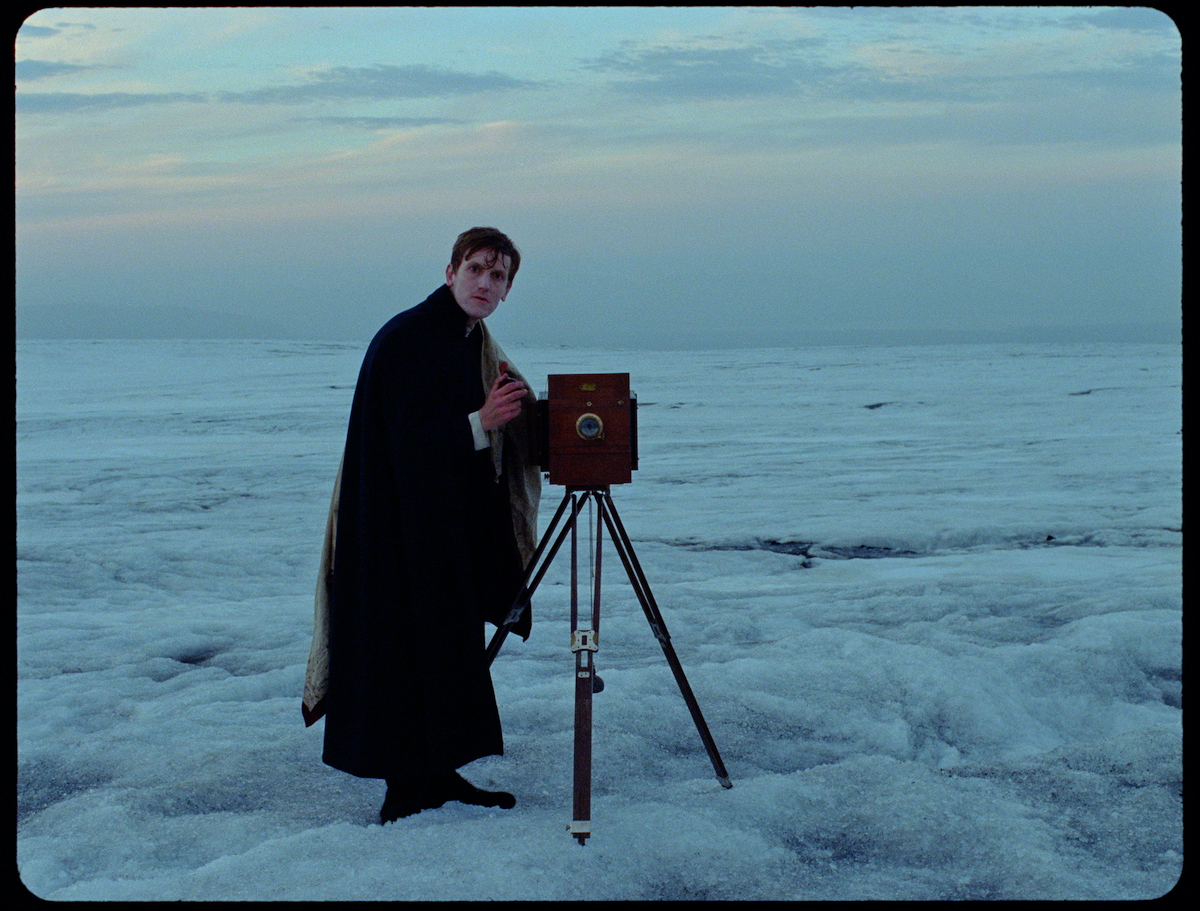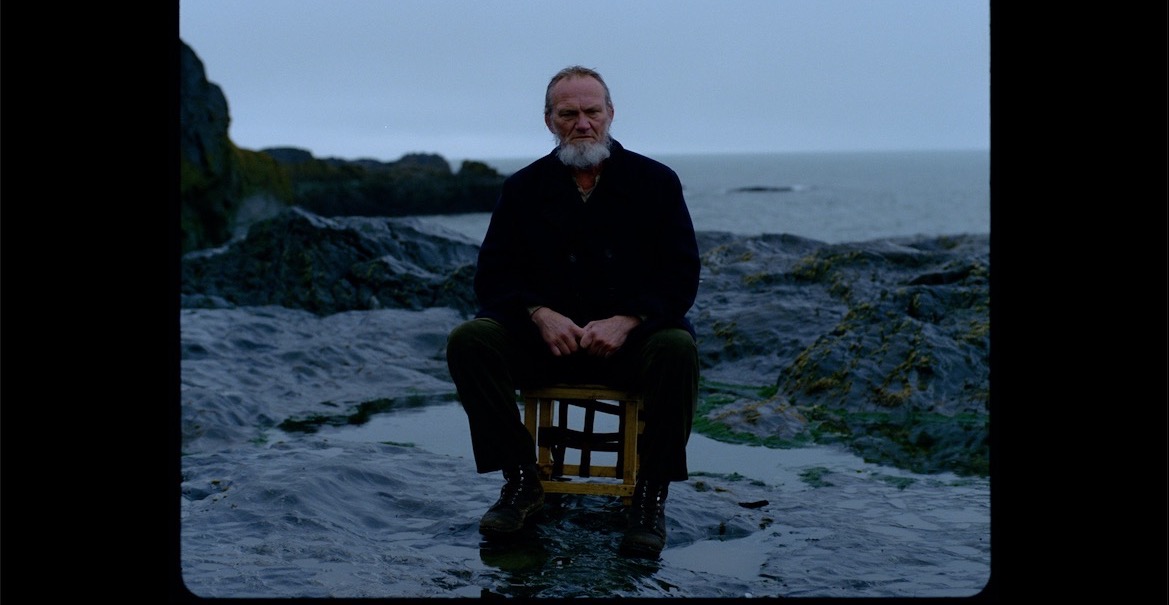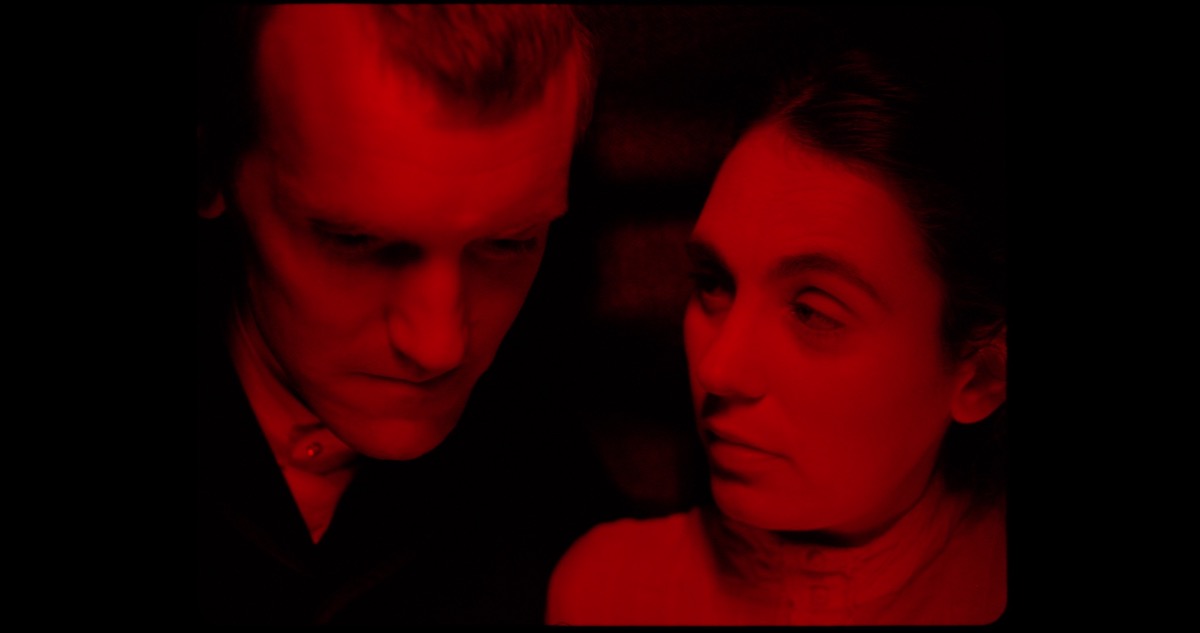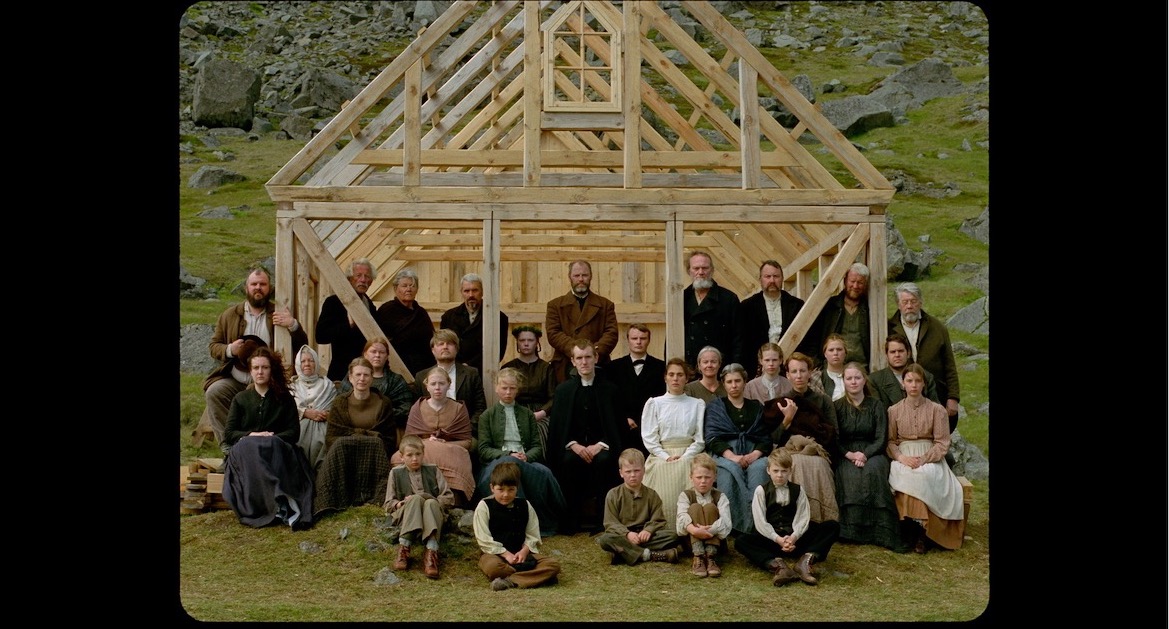Hlynur Pálmason’s third feature film is a beautifully crafted cinematic experience about the contentious definition of morality, ethics and perceived entitlement to nobleness. Steering clear of a pastoral or didactic tone the film bursts naturally out of the harsh, unwelcoming landscape of Iceland in all its glorious mysticism, whimsical cinematography and holiness of the analogue, 1:33 ratio aesthetics.
Trusting in the poetry of the analogue Hlynur Pálmason creates eloquent sequences or intricate visual tableaux about the treacherous mission of a young priest to establish a church in a remote location in Iceland, during the Danish occupation. The pilgrimage becomes a crusade, a process of conflict, defeat, erosion, decomposition and reinvention of how tradition, faith, humanity, mysticism and spirituality can be experienced. Echoing aesthetic elements and the film world of Carl Theodor Dreyer’s masterpiece, Ordet (1955), Pálmason presents his own take on the ethereal emerging out of the realistic quotidian experience, in development of what I would like to call his personal transcendental gaze.
A refreshing cinematic experience, Godland is a captivating work about the challenges of the human existence and the ways in which it can potentially connect to a higher power, at the backdrop of moral colonialism, power dynamics and the perception of family bonds. It is a film about morality, deconstruction and re-composition of principles, human values and the ties that bind.

The cumbersome daguerreotype equipment is a hard cross to bear for Lucas, the wide-eyed priest who abandons the comfortable habitats of the clergy in Denmark, to establish a church in a remote location in Iceland, meet and photograph its people along the way. There is a sense of refined nobility, raw curiosity, and humility to carry out his double mission to the best of his ability, as he steps onto the cold, unwelcoming Icelandic shore. At the same time, he carries himself with a certain sense of authority and entitlement, representing both the colonial rule, as a Dane, and a form of divine rule, as a priest. Taken completely by the surroundings and unfamiliar with the territory, he is guided by Ragnar, a local man with deep knowledge of the land, the climate and potential dangers associated with both. Lucas is the acting leader of his mission but cannot institutionalise the survival instinct, connection to the land and wisdom that stems from it, that one needs in order to accomplish the mission. He finds himself in need of trusting and relying on the locals, who object to acquiring the pre-figured role of a disciple and follow their own mission, instead.

Ragnar, beautifully played by Ingvar Sigurdsson, embodies exactly that. He appears to have been borne out of the glaciers and erupting volcanoes of his homeland, speaking only in his language, refusing vehemently to communicate in Danish. Direct, kind-hearted, and willing to help, but also curt at times, he is a true representation of the contradictory but coexisting elements of the Icelandic landscape. He lures visitors in, with his devotion to a pastoral lifestyle but as soon as they start becoming familiar with him and his beliefs, they are abruptly reminded that Ragnar’s allegiance to the pagan poetry of the local lore can and will be weaponised against their dogmas, beliefs, and socio-political conditioning, if need be.
While Ragnar tries to capitalise on the shock value and some type of environmental mysticism with his stories, Lucas attempts to restore the power dynamics by emphasising a moral-cultural high ground he believes that he possesses, by virtue of him being the only person with the skills, knowledge, and talent to use daguerreotype equipment to capture the image of the people he meets along the way. While Ragnar’s knowledge facilitates Lucas’ mission, it simultaneously challenges his ambition to assert himself as the person he wishes to be seen as, by the locals. The former’s skills, wisdom, and knowledge lead to a re-distribution of a previously conceived notion of hierarchy, which permeates the relationship between the two men and what they stand for, their journey and the entire film. Through conflict, competition and constant power struggle alternating with acts of humanity and pure kindness when the journey gets tough, the two men and their travel companions manage to reach their final destination.
Cut to the warmth and domestic bliss that Carl’s home is built on; a much-needed refuge for Lucas who survived the harshness of the perilous journey through the kind acts of strangers or his travel companions and the mere skin of his teeth. He makes it to the location where the Danish church is to be built, but he seems to be a changed man. His blank stare, frail frame, frazzled thoughts, mumbled words and overall weakness compile a distressing portrait of the person he is slowly becoming. The care, attention and love he receives from Anna, Carl’s daughter, is the emotional supply and he didn’t ask for but gracefully receives while making his way out of an ascetic way of living. His discipline and willpower to accomplish his mission by all means necessary is infiltrated with his love for Anna and his need to get to know her more or include her in his mission somehow.

While enjoying the hospitality of the locals and receiving the respectful treatment that his position commands, he is also met with scepticism and doubt by locals. It is not just the unusual way in which he carries himself, which is not suitable for the harsh environment and the human ecosystem developing around it. It is also what he, as a cleric from Denmark stands for and what a potential establishment of his notion of a spiritual house, that is, an official church might mean for the local community. The more Lucas’ mission progresses, the more confused he seems to become. The more he tries to embrace the local culture, the more doubtful the locals become about his potential integration in their community. The more he gets to know Anna and falls for her, the more resistance he experiences from her father and the locals about him being dedicated to a moral code and lifestyle which is almost incompatible to theirs. They are not willing to sacrifice Anna, a strong, charismatic person with a beautiful personality in the name of establishing some sort of peace with the things that Lucas represents.
What changes and what remains through this process is condensed in a single sentence uttered by Ida, Carl’s youngest daughter: “Something needs to die so that something else can be born”. This is expressed on a multitude of planes, ranging from the human experience, an organised code of ethics, the notion of a moral high ground and most importantly who has the authority to claim it first against the others. Both Lucas and the local community decide what to sacrifice and what to keep alive with regards to their principles, customs and way of being, while re-considering everything they had thought they were becoming in the process of living. What remains in the end is their portrait, a frozen moment in time which serves as much more than proof of their existence in a certain moment in time.
In an unexpected way, this becomes essentially the “church” the congregation as it were, albeit not everyone is welcome to participate equally in this type of sacrament. The daguerreotype apparatus and the processes associated with its maintenance and portrait-taking acquire a ritualistic sense both for the priest and the subjects. The former chooses who to grace a portrait with and the latter seem to feel seen, elevated to a higher, more refined version of themselves by virtue of participating in this new, mystical artistic experience. Lucas follows the steps religiously one by one, being attentive and careful towards the equipment itself and in the direction of the subjects, as it were, their positioning in front of the camera. He is determined to capture their life essence in a moment of complete stillness, as the process requires. Lucas’ criteria are not just based on an artistic potential of the photograph but seem to be imbued with certain biases and established ideas. He does not deem all the people he meets worthy of a portrait, or the time, and resources needed in order to process a daguerreotype and he is quite blunt about it. His persistent refusal to take a portrait of Ragnar is building up the tension between the two men, leading to a vicious war of mind games and verbal atrocities which culminate to one of the most powerful scenes in the film. Serving as a subtle, second narrative level, as it were, Lucas’ notion of a church is established also through the daguerreotype lens.

A priest without a church and a man who becomes another in the process of achieving his mission by all means, Lucas presents a remarkable character study. He embodies the interesting transformation of a man who begins as a wide-eyed, disciplined and devout man of the clergy to a man whose human nature takes over and transforms his personality, actions and decisions. Elliot Crosset Hove breathes life into the character of Lucas with subtlety, honesty and understated dexterity. Aloof and clumsy at times but quite decisive and forceful at others, he showcases great versatility and carries the film throughout. Equally, Ingvar Sigurdsson delivers Ragnar with stoicism and depth, skilfully mapping his own character’s journey in a meaningful way. By cleverly containing the pathos which his character is expected to showcase, he allows it to surface only in certain scenes managing to strike a chord with spectators’ hearts and minds that lingers.
While the performances by all cast members are remarkable, what truly makes this film stand out is the filmmaker’s dedication to the form of film. From his choice to shoot everything on film to the actual process of filming certain scenes for a period of time longer than a year, it seems that it is rather the form driving the story, informing the different narrative layers, as it were, rather than the other way around. Additionally, the marvellous look of the film, owed to the magnificent cinematography by Maria Von Hausholff, make the film feel like still photography evolving slowly, acquiring its own pace and unfolding naturally.
Some aesthetic choices which are reminiscent of Carl Dreyer’s work, albeit they are presented in a different context. Pálmason draws on Ordet’s (1955) sense of realism emerging out of the minimal, austere yet aesthetically eloquent mise-en-scène, and the ethereal or spiritual elements which emerge through the long shots, skilful use of light and contained rhythm. With attention to detail, Pálmason compiles realistic sequences of beautiful, almost still frames and allows the slow pace of the film to weave them into meaningful and porous aesthetic segments which allow enough space for a delicate sense of the unseen to come through. With slow, almost static scenes and sparse soundtrack, there is a peaceful stillness and the anticipation of movement which may happen in unexpected ways, or not at all. By creating these modest sequences of stillness, Pálmason invites spectators to fill the gaps with what they believe in and what they believe could be there. Finally, and more importantly he encourages all the whimsical elements of cinema to surface and come together in what each one of us can identify as that specific magic element of the medium.
By Eirini Nikopoulou.
The film is available in UK cinemas and exclusively on Curzon Home Cinema.
Info:
Writer, Director: Hlynur Pálmason. Producers: Snowglobe, Join Motion Pictures, Maneki Films, Garagefilm International. Cast: Elliott Crosset Hove, Ingvar Sigurðsson, Vic Carmen Sonne, Jacob Hauberg Lohmann, Ída Mekkín Hlynsdóttir. Cinematography: Maria Von Hausswolff. Editor: Julius Krebs Damsbo. Music: Alex Zhang Hungtai. Duration: 144 minutes. Countries: Denmark, Iceland, France, Sweden. Year: 2022. Language: Danish, Icelandic.
